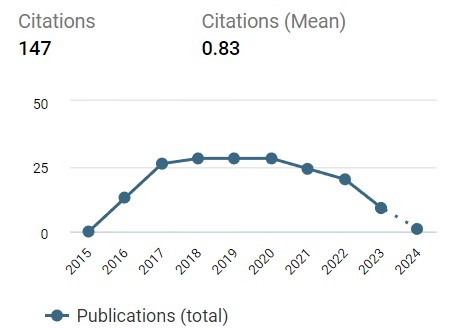CORN COB AND COCOA SHELL WASTE: A RENEWABLE ENERGY SOURCE SOLUTION
DOI:
https://doi.org/10.21831/dinamika.v10i1.83911Keywords:
Briquettes, Corn Cob, Cocoa Shell, Physical Properties, Thermal PropertiesAbstract
References
Ajewole, T. O., Aworinde, A. K., Okedere, O. B., & Somefun, T. E. (2022). Agro-residues for clean electricity: in-lab trial of power generation from blended cocoa-kolanut wastes. Heliyon, 8(3), e09091. https://doi.org/10.1016/j.heliyon.2022.e09091
Eka Putri, R., & Andasuryani, A. (2017). Studi Mutu Briket Arang Dengan Bahan Baku Limbah Biomassa. Jurnal Teknologi Pertanian Andalas, 21(2), 143. https://doi.org/10.25077/jtpa.21.2.143-151.2017
Firmanto, H. et al. (2023). PEMANFAATAN EKSTRAK KULIT BUAH KAKAO ( Theobroma cacao L .) UNTUK SUBSTITUSI SUMBER BASA PADA PRODUK SABUN MANDI CAIR. Seminar Nasional Teknik Kimia Soebardjo Brotohardjono XIX, 9(1), 78. file:///C:/Users/ASUS/Downloads/15-Article Text-110-1-10-20231020-7.pdf
Frenly Simanullang, A. (2021). Karakterisasi Sifat Fisis Papan Partikel Limbah Tongkol Jagung dengan Resin Epoxy Isosianat. Jurnal Ilmu Dan Inovasi Fisika, 5(1), 82–87. https://doi.org/10.24198/jiif.v5i1.30692
Hidayat, W., Haryanto, A., Ibrahim, G. A., Hasanudin, U., Prayoga, S., Saputra, B., Rahman, A. F., & Tambunan, K. G. A. (2022). Pemanfaatan Limbah Biomassa Jagung Untuk Produksi Biochar di Desa Bangunsari, Pesawaran. Jurnal Pengabdian Kepada Masyarakat (JPKM) TABIKPUN, 3(1), 45–52. https://doi.org/10.23960/jpkmt.v3i1.77
Kalsum, U. (2016). Pembuatan Briket Arang Dari Campuran Limbah. Distilasi, 1(1), 42–50. file:///C:/Users/Asus/Documents/FATHAN/PERPUSTAKAAN WINDOWS/Journal Pemanfaatan Pohon Aren/PEMBUATAN BRIKET ARANG DARI CAMPURAN LIMBAH.pdf
Maryono, Dan, S., & Rahmawati. (2013). Pembuatan dan Analisis Mutu Briket Arang Tempurung Kelapa Ditinjau dari Kadar Kanji Preparation and Quality Analysis of Coconut Shell Charcoal Briquette Observed by Starch Concentration. Jurnal Chemica, 74-83, 14, 74–83.
Mustain, A., Sindhuwati, C., Wibowo, A. A., Estelita, A. S., & Rohmah, N. L. (2021). Pembuatan Briket Campuran Arang Ampas Tebu dan Tempurung Kelapa sebagai Bahan Bakar Alternatif. Jurnal Teknik Kimia Dan Lingkungan, 5(2), 100–106. https://doi.org/10.33795/jtkl.v5i2.183
Qistina, I., Sukandar, D., & Trilaksono, T. (2016). Kajian Kualitas Briket Biomassa dari Sekam Padi dan Tempurung Kelapa. Jurnal Kimia VALENSI, 2(2), 136–142. https://doi.org/10.15408/jkv.v2i2.4054
Rachma, A. M., & Supriyo, E. (2022). Pembuatan Briket Arang Dari Kombinasi Bonggol Jagung Dan Tempurung Kelapa Dengan Polyvinyl Acetate (PVAc) sebagai Perekat. Metana, 18(2), 93–98. https://doi.org/10.14710/metana.v18i2.49325
Salamah, U., Muldarisnur, M., & Yetri, Y. (2019). Pengaruh Ukuran Partikel Kulit Buah Kakao Terhadap Sifat Fisik, Mekanik dan Termal Papan Partikel dari Kulit Buah Kakao dan Serat Ampas Tebu. Jurnal Fisika Unand, 8(3), 205–211. https://doi.org/10.25077/jfu.8.3.205-211.2019
Salcedo-Puerto, O., Mendoza-Martinez, C., & Vakkilainen, E. (2025). Solid residues from cocoa production chain: Assessment of thermochemical valorization routes. Renewable and Sustainable Energy Reviews, 208(February 2023), 115048. https://doi.org/10.1016/j.rser.2024.115048
Sukmawati, D., Rahayu, S., Supiyani, A., Supriyatin, S., Nabila, D. A., Zahra, L. N., Artanti, G. D., Setiarto, R. H. B., Nurhidayat, D., & El Enshasy, H. A. (2024). Pemanfaatan Limbah Kulit Biji Kakao (Theobroma Cacao L.) dalam Pembuatan Cookies bagi Masyarakat Pekan Nanas, Johor Bahru, Malaysia. Wikrama Parahita : Jurnal Pengabdian Masyarakat, 8(2), 255–263. https://doi.org/10.30656/jpmwp.v8i2.7484
Utomo Putro, M. B. K., Atmono, A., & Sulastri, S. (2024). Pemanfaatan Limbah Agroindustri (Tongkol Jagung Dan Kulit Buah Cokelat) Sebagai Bahan Baku Briket. Jurnal Lingkungan Dan Sumberdaya Alam (JURNALIS), 7(1), 66–74. https://doi.org/10.47080/jls.v7i1.2205





